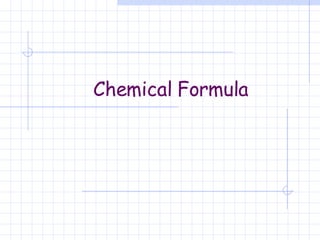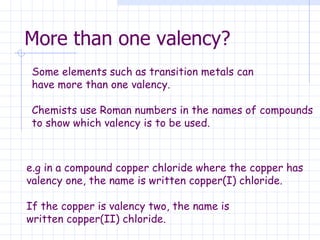Chemical Formula
- 2. Dictionary: The chemical formula of a molecule shows the number of atoms of each element in the molecule. Formula consists of the symbols for the elements that make up the molecule, each followed by a number.
- 3. Examples oxygen molecule contains 2 atoms O 2 bromine molecule contains 2 atoms Br 2 nitrogen molecule contains 2 atoms N 2 If the formula contains only one atom of a particular type, there is no need to put in ‘1’.
- 4. to do: Draw a target diagram for the following covalent compounds Draw a diagram of the molecule using lines to represent the covalent bonds Write the formula for each compound under the target diagram Hydrogen fluoride Carbon chloride Phosphorus hydride Sulphur oxide HF CCl 4 PH 3 SO
- 6. The valency of an atom depends on how many of its electrons are involved in bonding. Remember: 1 7 2 6 3 5 4 4 3 3 2 2 1 1 Number of bonds can form (valency) Group number
- 7. Valencies can be used to work out formula. Step 1: Write down the symbols for the elements present e.g. calcium cholride Ca Cl Step 2: write the valencies of the elements present above each symbol Ca Cl 2 1
- 8. Step 3: Cross over the valencies Ca Cl 2 1 Ca 1 Cl 2 Step 4: if there are any common factors cancel them out and omit any ‘1’ present The formula of calcium chloride is: CaCl 2
- 9. What about silicon oxide: Step 1: Write down the symbols for the elements present Si O Step 2: write the valencies of the elements present above each symbol Si O 4 2
- 10. Step 3: Cross over the valencies 4 2 Si O Si 2 O 4 Step 4: if there are any common factors cancel them out and omit any ‘1’ present In this case both factors can be divided by 2. The formula for silicon oxide is SiO 2 .
- 11. Examples: Phosphorus chloride Boron sulphide Silicon fluoride Sulphur chloride Phosphorus iodide Iodine bromide Boron chloride PCl 3 B 2 S 3 SiF 4 SCl 2 PI 3 IBr BCl 3
- 12. The same method works for compounds containing metals and non metals. Try these examples: Magnesium oxide Sodium chloride Aluminium iodide Potassium sulphide Lithium oxide MgO NaCl AlI 3 K 2 S Li 2 O
- 13. More than one valency? Some elements such as transition metals can have more than one valency. Chemists use Roman numbers in the names of compounds to show which valency is to be used. e.g in a compound copper chloride where the copper has valency one, the name is written copper(I) chloride. If the copper is valency two, the name is written copper(II) chloride.
- 14. to do: Work out the formula for copper(I) chloride and copper(II) chloride Work out the formula for the following transition metal compounds: Copper(I) oxide Tin(IV) chloride Iron(II) oxide Iron(III) sulphide Cu 2 O SnCl 4 FeO Fe 2 O 3
- 15. Transition metal’s name Transition metal’s symbol valency Copper(II) Copper(I) Tin(IV) Silver(I) Lead(V) Iron(III)
- 16. Using Prefixes In some cases the compounds name helps you to find the formula. six hexa five penta four tetra three tri two di one mono meaning prefix
- 17. Compound’s name Number of atoms of first element Number of atoms of second element Formula carbon monoxide sulphur trioxide dinitrogen tetroxide sulphur trioxide dinitrogen monoxide sulphur dichloride carbon tetrachloride carbon disulphide tri-iron nitrate
- 18. Examples Carbon monoxide mono = 1 one oxygen: CO Carbon dioxide di = 2 two oxygens: CO 2 Phosphorus pentachloride pent = 5 five chloride atoms: PCl 5

















